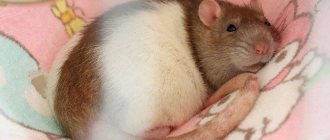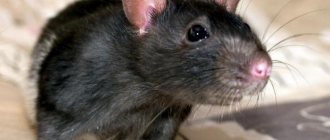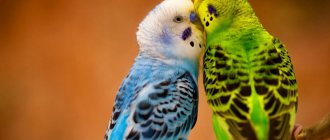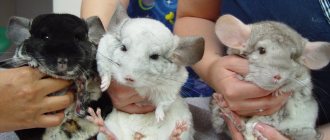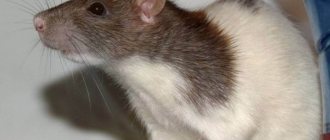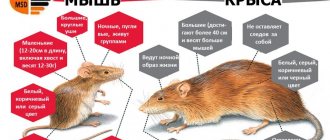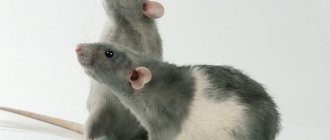An inexperienced owner of a pet rat may not even be aware of the imminent replenishment of his pet’s family, in which case the discovery of a whole brood of naked squeaking lumps in his pet’s cage may come as a complete surprise to him. Sometimes, owners purposefully breed a female rat to produce rat offspring at home.
What do newborn rat pups look like?
Newborn rats, of course, cause affection and a surge of tenderness, but now all worries about the nursing mother and her children fall on the shoulders of the rodent owner.
The baby rat looks very cute and touching, resembling a pink celluloid baby doll with pink skin and a large round head. Little rat pups are completely hairless and are born blind and deaf, although the sense of smell and instincts in these touching babies are already developed. By smell, the cubs find their mother's nipple, gorge themselves on nutritious milk and fall asleep near the warm belly of the female.
On the large head of a small rat, through the translucent skin, you can see huge dark balls of eyes, which indicates the dark color of the animal. If the contours and color of the baby’s eyes cannot be determined, then the rodent’s fur will be light: red, white or yellow.
A newborn rat pup is very small and defenseless, the weight of the pup at birth is only 3-5 g, the body length of females reaches 5-6 cm, males - up to 9 cm.
IMPORTANT!!! Newborn rat pups should not be touched. The baby’s body is very fragile, one awkward movement can kill the animal. The rat will also not accept a baby with the smell of human hands; excessive curiosity of the owner can result in the death of the baby.
Differences between old individuals
After six months, difficulties arise in determining the age of the animal during the weighing process. To do this, you need to take into account various external characteristics. You should pay attention to the length of the animal’s tail. If it is equal to the length of the body, then the animal is definitely more than a year old.
In addition, the following signs indicate maturity:
- Dull and sparse fur, sticking out in some places.
- Rough skin on the tail with a large number of keratinized flaking areas.
- A hunched body, indicating the absence of a fatty layer on the back, which is always present in young individuals.
- Long incisors with ground back.
How a rat takes care of its pups
Rodents by their nature are excellent mothers; a rat spends the entire day with its pups, tenderly caring for, feeding and caring for the babies. The female covers her large brood with her body all day, warming and protecting the cubs. The warmth of the rat's body and frequent feeding with nutritious milk stimulate the development of all organ systems of small animals; it is almost impossible to feed and keep newborn babies alive without the care of the mother.
Sometimes a rat produces a litter of 15-20 pups
, some of the stronger cubs more often than others end up near the nipple with milk, the rest of the pups may die without feeding. In such cases, in the second week, you can place briefly fed nimble babies in a separate container, maintaining a constant temperature of 39C in it; for this purpose, you can use a heating pad or bottles of warm water.
At birth, baby rats cannot empty their bowels on their own; the mother often licks the babies' bellies, stimulating bowel function and removing newborn feces.
A small rat is a completely hairless creature; the body of a tiny animal becomes overgrown with fur only in the second week of the rodent’s life. Decorative rat cubs are not able to maintain a constant body temperature, so naked babies physically cannot survive without the warm belly of their mother.
If the mother leaves the newborns for a few minutes, the body temperature of the pups instantly drops, they stop moving and fall asleep. The mother carefully monitors the body temperature of each baby all day, and if necessary, the rat changes places between the children.
The rat gradually reduces the time spent near children, adapting newborns to environmental conditions and independently maintaining normal body temperature. If at birth the female practically does not leave a brood, then by the end of the first week the babies spend a third of their time without their mother, with a further increase in their independent period.
Possible problems during pregnancy
The owner of the rodent needs to closely monitor its condition. In most cases, pregnancy proceeds normally, but sometimes complications occur. Health problems can be caused by stress.
Situations in which urgent veterinary care is needed:
- the rat is lethargic, does not eat anything;
- pus or blood is released from the genital loop;
- the baby rats do not move in the stomach - this can be detected at the end of pregnancy;
- labor lasts more than 5 hours.
Development of baby rats by day
Newborn rodents grow very quickly, a defenseless blind lump becomes an adult after 4 weeks, males reach sexual maturity at 5, and females at 6 weeks. The development of rat pups day by day is as follows:
1st day
Immediately after birth, the pups are naked, pink, blind and deaf babies with underdeveloped limbs and a small tail, who can only squeak, suck and sleep.
3-4th day
The cubs' ears open, and now the pups can distinguish not only smells, but also sounds.
5-6th day
The bodies of newborns begin to be covered with the first soft hair, the skin has become flesh-colored with dark spots, the presence of which determines the color of rodents.
8-10th day
The baby rats are erupting their first teeth, the babies are already covered with short velor fur, the cubs are becoming very nimble, they start fights over the mother’s nipple, their movements are not yet fully coordinated.
12-13th day
The babies' eyes open, the pups explore the territory, actively try to get out of the nest, but the rat diligently returns the children to their original place.
14-16th day
At this time, secondary sexual characteristics are formed and the sex of the animals can be determined; in females, nipples are visible on the abdomen.
16-18th day
Babies actively begin to taste their mother’s food, try to gnaw all surrounding objects, from this period the first complementary foods of animals can be introduced.
20-27th day
The cubs are practically independent individuals, feed on the food of adult animals, milk production declines, and lactation stops by the 27th day of the babies’ life. A physiological feature of rat pups is that during this period they eat the female’s feces and become accustomed to the mineral composition of the adult diet. The rat stops dragging newborns and takes care of the offspring less and less, teaching children to be independent. The babies are still attached to their mother; it is not recommended to separate them during this period.
28-30th day
The pups are already adults, they are curious about everything new, the kids begin to recognize people and play with their owners. In the wild, at the age of one month, rodents already become independent hunters, and provide their own food and housing.
How is it different from a mouse?
Newborn rodents of different species are often confused with each other. The little ones are very similar to each other, but there are still many differences between them. An attentive person will quickly determine by the appearance of the babies exactly whose nest he was lucky enough to discover.
Rat cubs from mice are distinguished according to the following criteria:
- Size. The body of a newborn baby rat will be longer than that of a mouse.
- Muzzle. In a baby rat, it seems to be chopped off and has bulging eyes covered with skin.
- Ears. In the vole they are round and large.
- Tail. Mice have a long and thin tail. It is equal to the length of their body.
The baby rats in the photo will be larger in size. They are slightly thicker and darker than a newborn vole.
When baby rats open their eyes
Little rat pups are born completely blind and deaf; for the first 12 days of life, the cubs are guided only by smell. Later, in adult life, the rat uses its sense of smell to explore the entire environment. Scientists have proven that episodic memory in rats is structured like that of humans; the animal is capable of not only capturing and distinguishing different notes of odors, but also of associating situations of their occurrence and manifestation. The first aromas that a newborn smells are the smell of milk and the body of its mother.
The eyes of rat pups open on the 12-13th day of life, the babies begin not only to smell, but also to see the world around them.
From the moment their eyes open and they gain the ability to see the world around them, rat cubs begin to actively leave the nest and explore new territories. Rats' eyes are located on the sides of their heads; this anatomical feature gives them a wide viewing angle. The animal, without turning its head, can look with both eyes in different directions, even up, back and down. In this way, nature protects wild rats from attacks by predatory animals and birds.
Character and lifestyle
Since Dumbo is not a separate species of animal, but only one of the rat breeds, the same traits can be traced in their character as in ordinary rodents:
- intelligence
- sociability
- good sense of smell
- friendliness
Dumbo is distinguished from its relatives by its inactivity and low activity. Although there are often exceptions to this rule.
Rodents need communication; they should be given at least 2 hours every day. Otherwise, rats may get bored and stop eating. If the future owner does not have so much time, he can buy a friend for his pet.
Caring for newborn rat pups
A rat cub is a defenseless, touching creature that requires increased care from its mother and owner. The mother will take care of the feeding and hygiene of the babies; the owner needs to properly care for the female and her offspring, without interfering with physiological processes. To do this, it is advisable to create comfortable conditions for newborn rat pups:
- In no case should you pick up or examine the cubs; the female may abandon or eat the brood from stress;
- the cage with the rat litter should be in the quietest, warmest and driest room;
- The rat cleans the nest on its own, throwing dirty pieces of bedding into the corner of the cage; the owner constantly needs to give the female clean napkins. You can remove used napkins from the cage no earlier than the 8th day of life, without touching the nest. If the rat becomes agitated when cleaning, put it down;
- watch the cage door, the cubs after the 8th day are very nimble and can jump out and crash on the floor, or the female will drag the newborns to any quiet corner of the apartment;
- feed the female with nutritious food and keep the drinking bowl filled with clean drinking water;
- Carefully introduce healthy complementary foods to babies for the proper development of the digestive system of newborns.
Features of birth
After the baby is 3–3.5 weeks old, the owner can pick him up.
Rodent breeders note that the more often you hold them in your arms, the more affectionate and obedient they will become. The key is to not overdo it. You need to know when to stop everything. Excessive affection is a factor in the development of stress in a pet. You should not separate the mother from the babies for a month. The immune system of newborn rat pups is directly dependent on how long they will be around it. The total growth period for rat pups is one year. As for nutritional features, after a month you can add cottage cheese, boiled chicken bones, apples, milk corn, and bananas to their diet. There are also a number of foods that should not be included in the diet of baby rats. These are yolk, broccoli, salads, cucumber, liver, tomatoes.
Experts in breeding animals of the rodent family advise adhering to the above recommendations at least until the baby rats reach three months.
The small animal is a defenseless creature that needs special careful care and maternal attention. The attitude of owners towards an animal should be the same as towards their child.
What I am a master at is talking incessantly about hamsters. I have three hamsters at home, and my husband has a pet rat. That’s how we live, the six of us eat, the six of us sleep :)
Post Views: 4,072
When can you pick up baby rats?
Touching baby rats immediately after birth is highly discouraged! The mother can eat a baby with a human smell, and there is also a chance of accidentally damaging the newborn’s thin bones.
Towards the end of the second week of life, you can briefly remove the newborns from the nest in the absence of the female, examine the pups and determine the sex of the animals. It is advisable to do this while wearing medical gloves or thoroughly washed hands so that the female does not abandon the brood.
From the end of the second week, you can take the babies out of the cage, often in the presence of the mother, so that the rat trusts you and does not worry about the children. Rats at this age are unusually nimble and inquisitive, while the female is on a walk every day, it is advisable to accustom the rats to friendly human communication: carefully carry in two palms, stroke, talk in a gentle voice, wear in the sleeve and in the bosom. Wary tiny animals quickly get used to people and begin to trust them.
IMPORTANT!!! Lack of active close communication with a person at a young age can make a pet fearful or aggressive towards humans.
What not to give
Often, owners of baby rats try to pamper the younger generation with something tasty. However, most delicacies from the human table are dangerous for rodents, especially for babies. The following are strictly prohibited:
- sugar and sweets - candies, milk chocolate, baked goods, ice cream, condensed milk;
- fatty meat, lard;
- semi-finished products - dumplings, dumplings, cutlets;
- sausages, sausages, smoked meats;
- fast food;
- dried, smoked, dried fish;
- fresh milk;
- mushrooms;
- radishes, beans, turnips, rhubarb;
- carbonated drinks.
You also need to carefully monitor the baby rats so that they do not eat forbidden foods. Some plants, for example, can be deadly for rats - aloe, lily of the valley, dieffenbachia, geranium, carnation, lupine, tulip.
A new addition to a rat family is a very important and responsible event. Knowing what to feed baby rats and how to care for them, even a novice breeder can raise healthy and active offspring without any problems.
When can you give away baby rats?
From 2 weeks of age, it is advisable to frequently pick up babies and give them treats from your hands.
, the animals will get used to doing without their mother and will remember the smell and voice of the owner. While feeding, the baby rat may bite its owner, mistaking its finger for a treat. It is absolutely forbidden to raise your voice in such cases and scare the baby.
At 5 weeks, males must be separated from their mother in a separate cage to avoid uncontrolled mating: an adult female can become pregnant, and from 6 weeks, young females can become pregnant. If possible, it is useful to keep boys with their father and girls with their mother; the cubs learn the life skills they need from adults. In the wild, rats also live in same-sex packs. Babies can be kept near a female or male for any length of time, taking into account the size of the cage and the number of pets.
After jigging, the young animals can be completely transferred to adult food, adding greens, vegetables, fruits and fish oil. At first, it is useful to feed babies with cow's or goat's milk from a pipette.
At 5-6 weeks of age, you can give away rat pups; it is highly not recommended to do this before 4 weeks of age; the cubs during this period are still breastfed; early weaning can negatively affect the health of the rat pup. A late change of owner is also undesirable; adult individuals get used to the owner and experience stress when the environment changes.
Birth
At the second stage of being in an interesting position, it is not recommended to disturb the female, namely:
- move the cell;
- pick up and so on.
This leads to termination of pregnancy.
In the process of bearing offspring, the female needs rest and a balanced diet.
The total gestation time of a rat is 23 days. By the time it ends, a number of hormonal changes are completed in the animal’s body. As for the external features of hormonal changes, they look like this:
- The female becomes somewhat nervous at the sound of someone else's baby squeaking.
- The creation of a nest for delivery is carried out by the animal independently a couple of hours before the start of the process.
- An interesting thing is that if during this period you place someone else’s baby next to the female, the expectant mother will accept him with great pleasure, despite the fact that she has not yet produced milk.
- During this period, the animal’s hostility towards any other animals increases significantly.
The female needs rest during delivery. Fear leads to spasms of the uterus and can provoke the death of an adult. Pathologies during delivery occur due to the non-standard position of the fetus. Often, the death of a female in the prepartum position occurs due to the decomposition of the non-surviving fetus or during pregnancy outside the uterus.
The traditional duration of birth for a rat is 2-3 hours. Before delivery, bloody fluid is released from the female’s perineum, after which the animal feels a contraction. The body is stretched and the sides are stretched to the limit.
Before the immediate appearance of the rat pups, the female sits down and assists their exit using her paws and teeth. The animal also pulls out the birth sac on its own, and then proceeds to the pups: licks them and gnaws the umbilical cord of each one. Experts note that after birth, the animals eat the placenta and umbilical cord. During the birth process, the baby begins to move and make sounds; these kinds of signals show the female that he is viable, and she cannot eat him.
Who is better to have: a boy or a girl?
All decorative rats are sociable, unpretentious, smart and easy to train.
When choosing a pet, you should take into account its character and the temperament of the owner. Most boys are phlegmatic, most of the time they rest in their house, hammock or in the arms of their owner. They sleep much more often than girls, eat more, and move less.
From 6–8 months, boys experience hormonal changes. This is manifested by bursts of unreasonable aggression towards relatives and the owner. You need to be prepared for this. In addition, males mark territory and people for whom they feel sympathy. Their urine has an unpleasant, pungent odor that is difficult to get rid of. For this reason, their cage has to be cleaned more often than the females’ home.
Rat girls are more active and restless. They bite owners more often than boys. Pregnant or recently given birth females who protect their offspring are especially aggressive.
Female rats also mark their territory, but much less often than male rats. In addition, their urine does not have such a strong odor.
Rats of both sexes are more active at night and sleep during the day. Therefore, the owner must accustom them to their schedule: games in the evening, sleep at night.
Interesting! The activity of female rats depends on hormonal levels. They are almost constantly in heat; their estrus occurs at intervals of 5–10 days and lasts 14–24 hours.
Males get along better with other pets than females.
Experienced breeders strongly recommend keeping rats in groups (from 2 individuals). They need communication with their relatives for a full life and good health. Solitary confinement does not suit them.
Setting up a house for a rodent
Aquariums are not suitable for this animal due to poor ventilation, and cages for hamsters are not suitable due to their small area. A cage for a pet rat should be special. This is, rather, a two-, or better yet, a three-story house, a kind of cottage with many different exercise equipment.
In addition to its impressive size, a house for a rat must meet the following requirements:
- the cage must be made of durable metal rods, which are spaced at a distance of 10 mm;
- a deep tray is required;
- all exercise equipment should be securely fastened;
- it is necessary to install a drinking bowl with clean water in the house; as a filler it is better to use paper without printing ink, sawdust, wood shavings (layer thickness - at least 5 cm);
- you need a shelter - a secluded place where your pet can rest, hiding from the direct rays of the sun; a children's plastic bucket or clay pot is suitable for arranging such a nest;
- You should clean the cage at least once a week - change the filler completely, clean the tray without using household chemicals with a strong aroma.
Unique Fertility
In the Russian Federation the following types are most often found:
- Gray or pasyuk;
- Black;
- Turkestan (red).
Pasyuk Black rat Turkestan rat
One can only wonder why nature awarded rats with such amazingly productive fertility. They live and breed all over the world, not paying attention to either cold or hot climates, and their activity lasts all round. And only unforeseen natural disasters or any mass diseases can temporarily reduce their numbers.
Scientists believe that it was humans who contributed to changes in the behavior and survival of rats. Living next to a person, eating the products that he produces, these rodents live freely and comfortably. After all, food is always available, and all the traps prepared by people can be avoided. And if one rat was poisoned, the others will no longer approach such food. These animals have a fairly high intelligence. It is assumed that they have the makings of abstract thinking, which helps them navigate and stay alive in an unfamiliar place. All these skills are adopted by subsequent generations.
And considering how rats reproduce, all that remains is to start fighting them in time, because their activity in this case can take on catastrophic proportions.
Complications
Poor nutrition, hormonal imbalances, illness, stress, or even a fetus getting stuck in the birth canal are some of the factors that can cause your upcoming labor or birth process to not proceed normally.
Signs of possible complications before or during labor may include discomfort. The following signs indicate discomfort:
- dull coat;
- stooped posture;
- strabismus;
- frequent difficulty breathing;
- unstable posture;
- body lethargy;
- excessive bleeding;
- pallor of the limbs;
- strong ineffective contractions;
- cessation of contractions, despite the appearance of new children.
Darker, thicker blood spots or brownish blood may also indicate problems. In the case of hemorrhage, babies usually cannot be saved. Blood loss in a female can be a life-threatening condition.
One of the most common complications is uterine inertia. Inertia occurs when the uterus does not contract with normal force and duration and at normal intervals during labor. Contractions stop or become too weak to push the fetus through the birth canal.
The rat's uterus is Y-shaped and consists of two uterine horns that extend into the cervix. A baby rat (or a couple of babies) can get stuck where the uterine horns meet. Sometimes the problem can be solved with a light massage. If a baby is stuck and cannot be dislodged, the babies behind it will die. Although the mother can ingest dead fetuses, there is always the possibility of infection, which can be life-threatening.
A baby stuck in the birth canal can sometimes be pulled out using soft forceps and a lubricant such as mineral oil. Often the mother can pull the newborn out herself. In such cases, you may end up with a baby rat with a birth injury (tooth marks, missing tail, bruises, etc.)
Signs of distress may indicate a need to visit a veterinarian. Depending on the problem, injections of Oxytocin (a medicine that causes uterine contractions), calcium and subcutaneous fluids, or possibly a caesarean section, may be required.
Sometimes during emergency sterilization, if the litter is full term, the babies can be retrieved alive, washed, and given to another mother to raise. This is not an easy process, but it can be done.
Types of breeding
In domestic rats, two types of crossbreeding are possible: selection of different breeds and purebred breeding.
In turn, purebred crossing is divided into the following types:
- Linear crossing;
- Inbreeding;
- Outcrossing;
- Outbreeding.
Linebreeding
Linebreeding or line breeding of rats involves crossing individuals that have a common ancestor. This method allows you to obtain viable offspring with a good genotype. In this case, homozygosity is preserved, and characteristics that do not satisfy the breeder are leveled out.
Inbreeding
To consolidate important breed qualities, the inbreeding method is chosen. Breeding rats in this way involves studying the gene pool and selecting quality sires among close relatives. With close inbreeding, a decrease in the number of viable offspring is possible - so-called inbreeding depression. To reduce the risk of such a situation, individuals for breeding are selected according to strict criteria.
Outcrossing
Outcrossing is used when it is necessary to increase the number of litters with valuable qualities. Mating uses individuals obtained by linebreeding, but without common ancestors in the fourth or fifth generation. To improve the breed, young animals that are unsuitable for a good genetic line are removed from the litter.
Outbreeding
To improve the quality of the breed and the health of the litter, outbreeding is the best option. With such crossing, individuals of a pure breed are selected, but without common ancestors. The disadvantage of this method of breeding is that there is a risk of unplanned characteristics and with frequent use, after several generations the proportions of the animal change.
Despite the different selection options that can be combined, there is still an unpredictable result. This is manifested in the color and length of the coat, the number of individuals in one litter, eye color, and level of health.
Bathing
Despite the widespread belief that pet rats love water, they are far from fond of bathing. Water procedures can be complicated by the animal’s pronounced resistance, but some pets are tolerant of this procedure - it all depends on individual characteristics. You need to bathe an animal in the following cases:
- if the wool has an unpleasant odor;
- if the rodent is unwilling or unable to care for itself;
- when infected with parasites.
